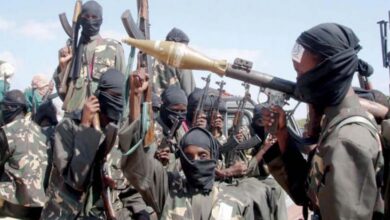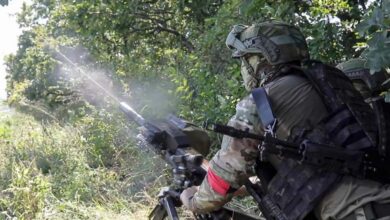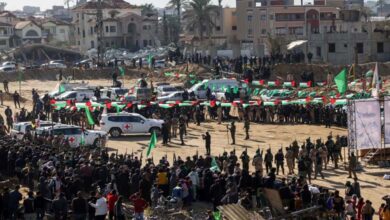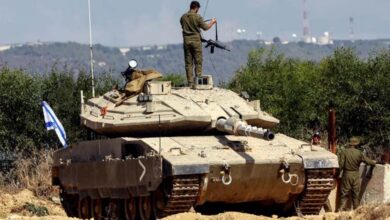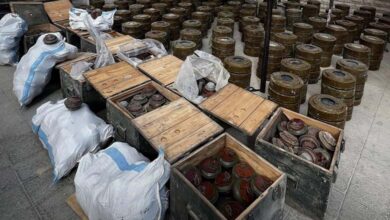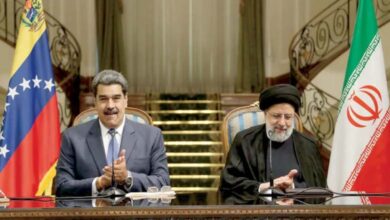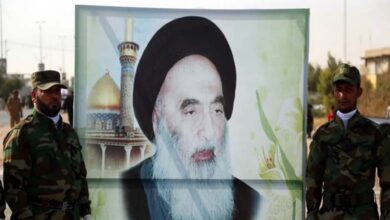Sinwar flirts with Nasrallah with a ‘rare’ message: Objectives and timing mystery

In his second message within days, breaking a year-long silence, Yahya Sinwar, the head of Hamas’ political bureau, sent a letter to Lebanon’s Hezbollah militia, raising questions about its timing and objectives.
-
Washington Accuses Hamas Leaders of Terrorism, Including Sinwar
-
How Did Hamas Leader Fall into the Beggar and Vendor’s Trap? Details of the “Ghost” of Hamas Assassination
As the prospect of a truce fades due to the intransigence of both Hamas and Israel in reaching a compromise, and amid the U.S. freezing its proposals to revive hopes of reaching one, the escalation between the Palestinian movement and the Israeli state has reignited.
In the midst of this escalation, Yahya Sinwar wrote a rare letter to Hezbollah leader Hassan Nasrallah, according to the Lebanese militia, reaffirming his “commitment to fighting Israel and supporting the Iran-backed alliance of militants known as the ‘Axis of Resistance.'”
-
Nasrallah Ridicules Israel’s Capability to Wage Wide War in Lebanon
-
Tough-Talking Haniyeh Was Seen as the More Moderate Face of Hamas
Flirting with Iran
Sinwar, Hamas’ political leader who is believed to be hiding underground in Gaza, told Nasrallah that the Palestinian movement is “committed to the path of resistance followed by his predecessor Ismail Haniyeh, and to the unity of the Islamic nation, with the Resistance Axis at its heart, confronting the Israeli project.”
According to CNN, the message, published by Hezbollah’s channel on Telegram, was written to express gratitude for Hezbollah’s ongoing battle against Israel, which began on October 8, a day after Hamas launched an attack on Israel, prompting a devastating Israeli response in Gaza.
-
Hezbollah was aware of Hamas’ attack half an hour before its execution
-
Liberman: The war will end when Hezbollah is completely removed
Sinwar, one of Israel’s most-wanted men, has not been seen since the war. He had not spoken publicly for nearly a year – until this week.
On Tuesday, he issued his first statement since the war, congratulating Algerian President Abdelmadjid Tebboune on his election victory, according to Hamas’ Telegram channel. The next day, his office said he had written letters of thanks to those who offered condolences following Haniyeh’s death.
-
Hezbollah’s Response to Chokr’s Assassination Eased Tensions
-
What Weapons Will Hezbollah Use in an Open War with Israel?
Objectives and Timing Mystery
Regarding Sinwar’s message, Gaza-based political analyst Mohamed Shehada said, “He is trying to say: I am here, I am alive, and I am leading with full strength. I am fully aware of everything happening outside Gaza.”
Shehada added that Sinwar “wants to show that he can operate on multiple fronts: the internal front — the battlefield in Gaza — and the diplomatic front — mediation.”
-
Washington Post reveals how Lebanese pay the price for Iranian threats and ongoing Hezbollah-Israel clashes
-
Hezbollah Bets on Tunnel Warfare in Confrontation with Israel
He pointed out that the primary audience for such messages is Israel, emphasizing that Sinwar seeks to show Israel that despite efforts to track him down, he is still capable of continuing to operate without interference.
Another target, according to Shehada, is Hamas, including “doubters within the movement or even mediators, who question his ability to lead from the tunnels in Gaza.”
-
Can Israel Deter Hezbollah? Dark Scenarios for a Potential Confrontation
-
New U.S. Sanctions Targeting Yemeni Houthis and Lebanese Hezbollah
Sinwar was appointed Hamas‘ political leader after Haniyeh’s assassination in the Iranian capital, Tehran, in July. He is seen as more hardline than his predecessor in dealing with Israel, favoring cooperation and close ties with Iran and allied groups like Hezbollah.
Shehada added that Sinwar is “one of the strongest advocates for a closer relationship with Hezbollah and Iran, deepening the alliance with the Resistance Axis.” He is viewed within the movement as a pragmatic figure, but also unpredictable and highly impulsive.
-
Crisis Between Defense Minister and Army Chief Amid Heightened Tensions Between Hezbollah and Israel
-
12 Hours of Chaos in Israel “Saved” Hezbollah from a Potential Strike
In his letter to Nasrallah, Sinwar vowed to continue defending Islamic holy sites, foremost among them Al-Aqsa Mosque in Jerusalem, “until the occupation is expelled from our land and we establish our independent state with full sovereignty and Jerusalem as its capital.”
He added that the October 7 attack was “one of the most honorable battles in the history of our Palestinian people.”
Exchange of Fire
The border between Lebanon and Israel is witnessing daily exchanges of fire between Hezbollah and Israel. Hezbollah claims to be targeting Israeli military positions “in support of Gaza and its resistance.” In response, Israel strikes what it describes as the group’s “military infrastructures,” along with its fighters.
Since the escalation began, at least 622 people have been killed in Lebanon, mostly Hezbollah fighters and at least 142 civilians, according to an AFP tally based on official data and Hezbollah and other group obituaries.
-
Hezbollah Conceals Its Losses with Promotional Displays of the ‘Hudhud’ Drone
-
Know Hezbollah’s “Primitive” Tactics in Confronting Israeli Technology
On the Israeli side and in the occupied Golan Heights, authorities have reported the deaths of 24 soldiers and 26 civilians.



